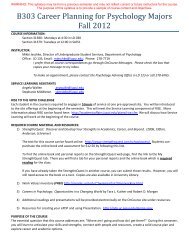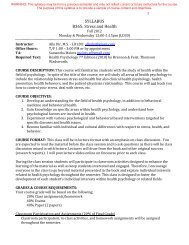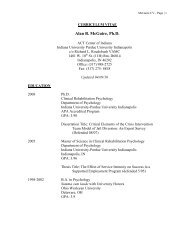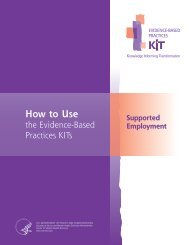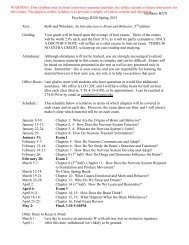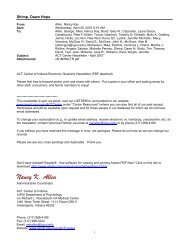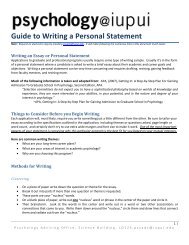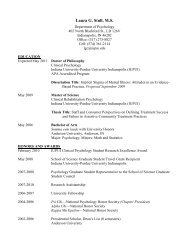Supported Employment: Training Frontline Staff - SAMHSA Store ...
Supported Employment: Training Frontline Staff - SAMHSA Store ...
Supported Employment: Training Frontline Staff - SAMHSA Store ...
Create successful ePaper yourself
Turn your PDF publications into a flip-book with our unique Google optimized e-Paper software.
Using minimal eligibility criteria<br />
This section describes issues related to determining<br />
who may benefit from SE, as illustrated by Caleb’s<br />
story. After reading the vignette, think about what<br />
you would do if you were Caleb’s employment<br />
specialist.<br />
As Caleb’s employment specialist, you could<br />
educate his treatment team about how work may<br />
motivate him to manage his substance abuse.<br />
Suggest that a plan be developed with Caleb<br />
focused on managing his work earnings. When<br />
working with Caleb, consider jobs that are in<br />
substance-free environments.<br />
Caleb’s story<br />
Caleb is a 28-year-old man with co-occurring disorders<br />
of schizophrenia and substance use disorder. During a<br />
weekly team meeting, Caleb’s case manager reported<br />
that Caleb has expressed an interest in getting a job.<br />
The case manager described his concern about Caleb<br />
increasing his alcohol and marijuana use if he earns<br />
money. The past two urine screens have indicated that<br />
he continues to use substances.<br />
Making the referral process simple<br />
The following vignette illustrates the importance<br />
of having a simple referral process and the steps<br />
needed to engage consumers after a referral has<br />
been made. After reading the vignette, consider<br />
how you would address Sandra’s interest and<br />
concerns about work.<br />
Tackling the issues<br />
Q: If you were Caleb’s employment<br />
specialist, what would you do<br />
While there is no single correct answer for handling<br />
Caleb’s situation, here are a few ideas:<br />
In SE, consumers who express interest in working<br />
are referred directly to the SE program. They are<br />
not screened for abstinence, work readiness, or<br />
cognitive functioning, etc.<br />
<strong>Employment</strong> specialists inform clinical treatment<br />
team members of the SE referral process and<br />
encourage them to make referrals. The criteria for<br />
receiving SE services should be kept to a minimum.<br />
Typical eligibility criteria are—<br />
1) consumers who are unemployed (or working<br />
noncompetitively) and want competitive work,<br />
or<br />
Sandra’s story<br />
After 4 years of unemployment, Sandra approached<br />
her case manager to discuss the possibility of<br />
returning to the work world. At first, Sandra expressed<br />
concerns about her ability to deal with what she<br />
perceived to be the stress of working.<br />
Tackling the issues<br />
Q: If you were Sandra’s employment<br />
specialist, what would you do<br />
While there is no single correct answer for handling<br />
Sandra’s situation, here are a few ideas.<br />
The process for referring Sandra to SE services<br />
should be as simple as possible, standardized, and<br />
widely known by all. Sandra’s referral could be<br />
made either orally or in writing, with the critical<br />
information recorded on a simple form. (Your SE<br />
2) consumers who are working but not receiving<br />
the employment supports that they would like.<br />
Module 2 2 Referral, Engagement, and Benefits Counseling



